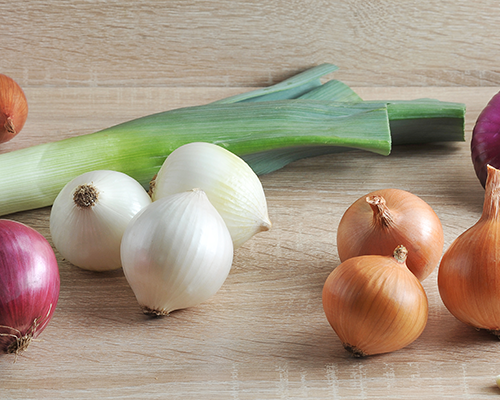By Danilo Alfaro
The humble onion is as indispensable to the culinary arts as butter or eggs—or for that matter, knives or plates.
It’s the rare food that can be sweet, savory, pungent and aromatic all at the same time, but that’s what onions do. In a real sense, onions are what make food food—going beyond mere sustenance and making it enjoyable. Making it taste good.
A Culinary Luxury
Thus, onions are a luxury, yet these small, brown, sulfurous orbs are cheap and plentiful and will grow just about anywhere, as evidenced by the fact that every style of cooking on earth features them.
Onions can be roasted, grilled, pickled, caramelized, battered and deep-fried, sliced thinly or chopped and served raw in salads, sandwiches, dips, or as a garnish for tacos, making them among the most versatile and ubiquitous ingredients in the culinary arts.
Onions make up a third of the classic mirepoix, a basic mixture of onions, carrots, and celery used to enhance the flavor of soups, stocks, and sauces, appearing under different names in different cuisines, such as the Italian soffritto, or the so-called “holy trinity” of Cajun cooking (which substitutes bell peppers for the carrots).
Onions are part of the genus Allium, and they’re related to garlic, chives, shallots, and leeks. Both the bulb and the shoots are edible. Slicing onions releases a sulfur-based vapor that irritates the eyes.

China produces the most onions of any country on earth, but they have 1.3 billion people to feed, so they use most of what they grow. Interestingly, the world’s top onion exporter happens to be the Netherlands.
Yellow Onions
The workhorse, the staple, the everyday brown beauty, yellow onions are suitable for any conceivable use, other than perhaps as a garnish for your martini (use a pearl onion for that). You could easily live a rich and fulfilling life even if this were the only onion you ever tasted.
Its heavy brown parchment skin surrounds ivory white flesh with a strong, sulphury, pungent flavor and aroma. If a recipe says onion without specifying what type, it’s assumed to be a yellow onion. Use them for making French onion soup.
Sweet Onions
Larger and slightly flatter than yellow onions, with lighter colored, less opaque skin, sweet onions contain extra sugar, making them good for caramelizing. Their larger size and sweeter flavor make them ideal for making onion rings. Sweet onion varieties include Walla Walla, Maui, Vidalia, as well as others with the word “sweet” in the name.
White Onions
White onions have a papery white skin, and their flavor is milder and sweeter than yellow onions, making them good for serving raw in fresh salsa or homemade guacamole.
Red Onions
Sweet and mild enough to be eaten raw, both the exterior skin and the flesh of red onions are a deep magenta color, which makes them particularly good additions to salads or anywhere else a splash of color will enhance the appearance of the dish. I love to use red onions in salads and on sandwiches and burgers.
Green Onions
Green onions are immature onions that have not yet formed a bulb, or only partially. The entire plant is usually used, including the tall green shoots, and they make a wonderful garnish for soups, omelets, tacos, as well as color and crunch. They go by other names, including scallions, spring onions, cebollitas (in Spanish), salad onions, and even—shallots!
That’s right, in some countries in which English is spoken, green onions are referred to as shallots, sometimes “French shallots,” to avoid further confusion. The differences in how we refer to culinary items and ingredients are wide even if the same language is used. However, green onions, shallots or cebollitas can be easily recognized by their aspect and taste, regardless of their name.
Leeks
Leeks are a truly marvelous vegetable, and also sadly underappreciated. Shaped like overgrown scallions, leeks are lovely in soups and sauces, and one of our favorite ways to prepare them is à la gratinée—baked and topped with seasoned breadcrumbs and Gruyère cheese. Baking the leeks mellows their flavor and softens them.
Shallots
Shallots are small, brown-skinned onions with purplish flesh, and their bulbs are made up of multiple lobes, a little bit like the way garlic bulbs are divided into individual cloves.
Pungent and garlicky, shallots are somewhat unappreciated in the United States—at least based on how infrequently they appear in recipes, and the careless disarray with which they tend to be displayed at the supermarket.
Which is a shame because shallots are possibly the most sublime onion. They impart a very intense flavor, and because they’re smaller, composed of thinner layers, they can be minced very finely and used in salad dressings and sauces. They’re lovely to roast, however; peel and halve them, and toss them in the bottom of the pan when you’re roasting a chicken.
source: thespruceeats.com
Download the full issue of the Mar-Apr 2023 Healthy Options News Digest here.





